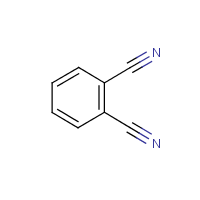1,2-Benzenedicarbonitrile
Agent Name
1,2-Benzenedicarbonitrile
Alternative Name
o-Phthalodinitrile
CAS Number
91-15-6
Formula
C8-H4-N2
Major Category
Nitrogen Compounds

Synonyms
o-Phthalodinitrile; 1,2-Benzendikarbonitril [Czech]; 1,2-Benzodinitrile; 1,2-Dicyanobenzene; Ftalodinitril [Czech]; Ftalonitril [Czech]; Phthalic acid dinitrile; Phthalodinitrile; o-Benzenedicarbonitrile; o-Benzenedinitrile; o-Cyanobenzonitrile; o-Dicyanobenzene; o-Pdn; o-Phthalodinitrile; ortho-Dicyanobenzene; [ChemIDplus] UN3439
Category
Nitriles
Description
Beige solid; [Hawley] Off-white or beige powder; [MSDSonline]
Sources/Uses
Used as an intermediate mainly for the production of phthalocyanine dyes; Also used in sintering metals; [ACGIH]
Comments
Inhalation of high concentrations may cause CNS effects; [ICSC] Emergency treatment: "Benzyl cyanide"; [HSDB] Lethal doses cause tremor and convulsions in rats; [RTECS] TLV Basis = convulsions and decreased body weight; Unlike the aliphatic nitriles, aromatic nitriles such as m-phthalodinitrile do not liberate cyanide in the body. [ACGIH] An acute neurotoxin; Not irritating to skin or eyes; [Reference #1] See "m-Phthalodinitrile." See "NITRILES."
Reference Link #1
Biomedical References
Exposure Assessment
Skin Designation (ACGIH)
Insufficient data
TLV (ACGIH)
1 mg/m3, Inhalable fraction and vapor
Vapor Pressure
0.00569 mm Hg
Explanatory Notes
Flash point = 162 deg C; [CHEMINFO] The Guide in the Emergency Response Guidebook is for "Nitriles, toxic, solid, n.o.s."
Adverse Effects
Neurotoxin
Other CNS neurotoxin
Diseases, Processes, and Activities Linked to This Agent
Processes
Industrial Processes with risk of exposure: